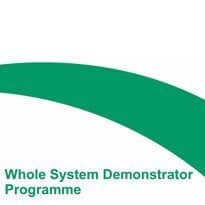Telecare “not magic bullet” – WSD study
- 1 August 2014

Policy makers have been warned to avoid describing telecare as a “magic bullet” in the latest study to cast serious doubt on the cost effectiveness of remote monitoring and intervention.
Writing in the journal Age and Aging, Catherine Henderson and 15 colleagues from UK universities, report back on the telecare element of the Whole System Demonstrator projects [free abstract, paid for article].
The WSD projects in Newham, Kent and Cornwall were set up by the Department of Health in 2008, with the explicit aim of finding an evidence base for telehealth and telecare.
A single paragraph of ‘headline findings’ were used in December 2011 to justify the launch of the 3millionlives programme to try and kick-start the industry.
At the time, Prime Minister David Cameron claimed the NHS would spend £750m implementing the technology, but save £1.2 billion a year; helping individuals and driving innovation in the process.
However, since then, more detailed results from the evaluation of the telehealth elements of the WSD programme have found they are not cost effective and may not be of much benefit to patients.
The new study looked at telecare, and compared a group of patients who received ‘second generation’ packages of sensors, monitoring devices, and call centre support, with a control group that did not receive the same interventions.
In total, some 1,276 people received some kind of telecare package, while there were 1,324 people in the control group. The study used questionnaires to establish the health status of both groups and their use of services.
It discovered that the use of services such as home care and social work was actually greater in the telecare group, with people in this group receiving an average of 42 home visits over the year of the study, while people in the control group received 33.
This, plus cost of the telecare package itself, meant that the costs of caring for the telecare group were higher than the costs of caring for the control group.
The average cost of the equipment and support package was £791, adding around 9% to the health and care costs of those in the telecare group, which were around 15% higher than those in the control group.
In return for this, the study says “there was a small, not statistically significant difference” in the mean quality adjusted life year – a measure of the impact of disease on the length and quality of life that is widely used in assessing the value for money of medical interventions.
The cost per additional QALY worked out at £297,000; which, the study notes, is unlikely to be regarded as cost effective by commissioners.
The National Institute for Health and Care Excellence uses a QALY of £20,000-£30,000 to decide whether to recommend the use of new drugs and treatments to the NHS.
But the study says statistical analysis suggests that only 15% of decision makers would be likely to regard telecare as cost effective at £30,000 a QALY at the study prices.
It suggests that a third might regard telecare as cost effective at £30,000 a QALY, if a “mainstream” package of telecare could be had for £5 a week.
In a discussion, the authors acknowledge that the extra, ‘traditional’ services received by telecare recipients could well have benefited them, and that some other benefits of the technology – for example for carers – may not have been captured by the study.
“However,” they conclude, “we found that a package of second-generation telecare equipment [and monitoring services] did not constitute a cost-effective alternative to usual care, assuming a commonly accepted willingness to pay for QALYs.
“For the present… policy makers should avoid characterising the technology as a ‘magic bullet’.”




